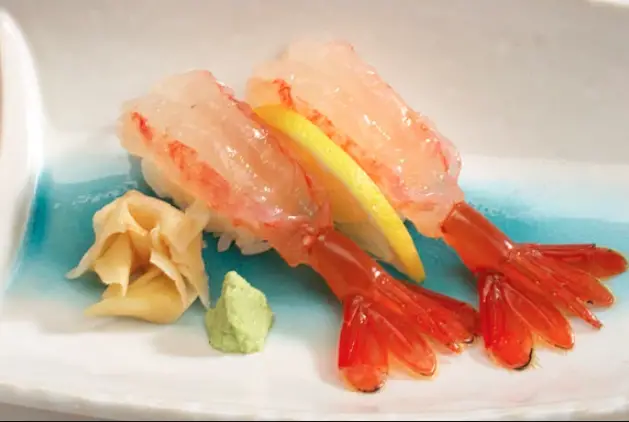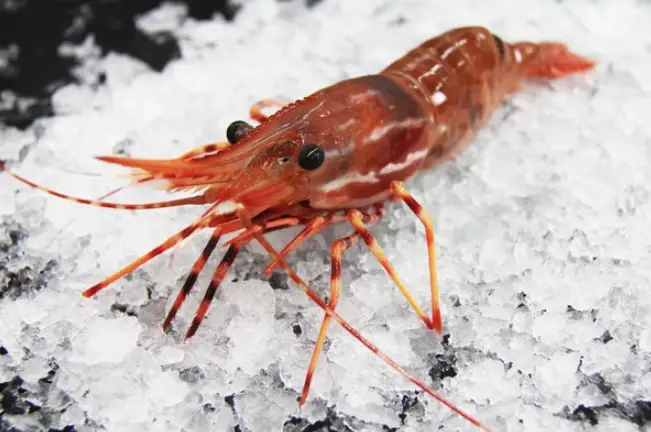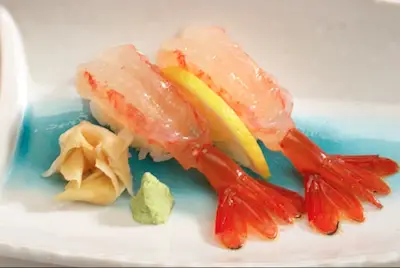We are reader supported. When you purchase through links on our site, we may earn an affiliate commission. Also, as an Amazon affiliate, we earn from qualifying purchases.

If you are a fan of raw seafood and love to dine at the finest sushi restaurants, you have probably come across ‘amaebi sushi’ in the menu. It refers to live spot prawns or cold water northern shrimps that are caught small and served as a fresh and raw delicacy.
What is amaebi sushi? Sweet, soft, and translucent, words are not enough to describe this traditional sweet seafood served as a topping with nigiri or a delicious filling in sushi rolls. They taste best when eaten raw because cooking strips them of their exotic sweetness.
Ama means sweet in Japanese and ebi means shrimp, so it can be clearly translated as sweet shrimp meant to be a fine raw delicacy. They are often referred to as live spot prawns. Amaebi sushi may often be served with their fried shells and heads to add a bit of crunchiness to the dish. Let’s take a closer look at the shrimps’ journey from the ocean to the table.
Amaebi is a shrimp species that thrive in very deep waters of the Canadian Pacific. They can be found in 500 to 2000 feet underwater. Those who are worried about overfishing need to know that they are highly abundant so you can indulge without any guilt. They are a highly fertile species so there’s less risk to the sustainability of the sushi.
Contents
Amaebi Are Hermaphrodites!
Interestingly, when you order the shrimp called ama ebi, you may either get the male or female form on the table because they are known to change their sex after a certain period. They are famous for this sexual transformation, hence are categorized as hermaphrodites.
The amaebi start out as males and they spend the first stage of their lives like that. After a year or two, they undergo a transition and become females. The testicles turn into ovaries, and they are capable of reproducing or laying eggs. The shrimp completes the remaining life as a female.
An interesting aspect of their sex-change cycle is that if there’s an abundance of female shrimps, the males take time to undergo a transformation. Similarly, if there is a shortage, they will kick start their transformation earlier to maintain the balance.
The short shrimps are usually scooped out before they change their sex to be served as a raw delicacy. The reason is that when they are caught in their male stage, the shrimps are at the peak of their sweetness. As they are very small, they are often served two at a time.
When caught in their female form, they lack their characteristic sweet flavor. The large-sized female amaebi are usually caught when they are carrying eggs as they carry them for about ten months. When female amaebi is used in sushi, their blue eggs lend rich texture to the dish.
Despite being called by the same name, the female amaebi are not as sought after as the males simply because they lack sweetness. The flavor is also not as concentrated as it is before the transformation.
Signs To Look For When Buying Amaebi (Spot Prawns)
Once the spot prawns are out of the sea, they are mostly frozen on the dock. However, they might sometimes be live and even shipped live to restaurants and seafood lovers who wish to make their own amaebi sushi at home. If you are buying spot prawns from a local fishmonger or supermarket, here are a few signs that indicate its freshness.
- For utmost freshness, look for the live and translucent prawns. Freshly harvested shrimps should smell of the ocean, not ammonia.
- The tail part should be properly aligned with the head. If it’s curled then probably the amaebi is not fresh enough
- Touch to ensure that the flesh is firm enough, specifically the head part. If it feels too mushy or soft, the meat within the hard shell will also be mushy
- If the outer skin of the prawn appears pinkish with the tail section curled up. This implies the amaebi is not fresh enough for raw consumption.
- There should be few or no black spots on a fresh prawn. Black spots on the head indicate that the meat has started to deteriorate.
- Properly frozen shrimps (at approximately -30° C or -20° F) will stay good for about 9 months. Once thawed, make sure you make amaebi sushi within 2 days.
Handling and Processing Live Spot Prawns (Amaebi)
Now that you know what is amaebi sushi, you may be yearning to get your hands on some live spot prawns that you can prepare at home and impress everyone. If you are able to buy live spot prawns from the market, consider yourself lucky.
Bring them home in a small cooler filled with ice packs because it is important to keep them alive until you reach home. Be careful when keeping your prawns in ice because if the ice melts, the prawns can submerge and die. Just keep them cool and an ice pack usually works fine.
To keep your spot prawns in the best condition, it’s essential that you don’t let them die or sit outside in room temperature with the head attached. When prawns or shrimps die, their head releases an enzyme that spreads across the body and turns the flesh mushy and black.
If you want to enjoy the highest quality prawns, you must either cook them live with the head or be-head it while it’s still alive. To remove the head, grip the body in one hand and the head in another, now twist the head part and it will come off easily. Take a look at this video where a chef from Catalina Offshore demonstrates it for you.
After the head part has been removed from the live prawn, wash off the tail in cold water. The tails of a fresh amaebi are soft and safe enough to be consumed raw. Alternatively, you may fry the tail and head part in a little butter and eat them with your amaebi sushi.
Peel off the outer shells from the body and remove the vein as shown in the video. You can now use it in your sushi recipe. For nigiri sushi, first, cook sushi rice and season it with vinegar, salt, and sugar as per the instructions provided in this article.
You may add a dash of sauce to enhance the flavor of the meat. While the male amaebi tastes best when consumed raw, the female prawns taste best when cooked. Place the raw or cooked prawn over a bed of seasoned rice and serve it with wasabi and pickled ginger.
Tips For Preparing Amaebi Sushi Correctly
- The fresh and healthy shrimps are clear and translucent. If the outer color is pink, this implies that it’s not as fresh as it should be.
- If you prefer to cook the spot prawns, make sure you do only for 1-2 minutes or until they turn pink because overexposure to heat can make the meat chewy.
- The head is often served with seasoned rice. It may be fried with a little potato starch or consumed whole as soft shell crabs.
- When rinsing amaebi, never put them under tap water as the chlorine content can kill them immediately. Also, don’t leave them out for long if you wish to eat them raw.
- You may marinate the spot prawns in light citrus sauce or soy sauce to enhance the flavor.
Amaebi Sushi Recipe (Nigiri And Maki Roll)

Most people like to eat fresh live spot prawns for their crunchy texture. However, if you leave the peeled shrimps inside the refrigerator overnight, the sugars begin to develop and lend a sweet flavor to your raw delicacy. For this recipe, I have cooked the shrimps so female spot prawns work fine.
What you will need:
- 2 cups of seasoned sushi rice
- Nori sheets
- 2 lbs spot prawns or amaebi
- 1.5 teaspoon salt
- 1/4 cup corn starch
- 1.5 teaspoon pepper
- Avocado (pit removed and finely sliced)
- Cucumber (cut into thin strips)
Instructions
First, you will need to prepare sushi rice in the traditional method. I have created an article to explain the step-by-step instructions for beginners.
If you bought live prawns from the grocery store, prepare them in the way shown in the video above. Keep a bowl of icy water while you peel the prawns and put them inside it to get a crunchy texture. If you wish to make nigiri sushi, drain the water and place the raw shrimp over a bed of seasoned rice.
To cook the female shrimps, take a small bowl and mix cornstarch, salt, and pepper. Keep aside. Put a medium-size saucepan on the stove and heat some canola oil to nearly 375 degrees.
Toss the peeled shrimps into the dry mixture and drop it carefully into hot oil and fry for 1-2 minutes or until they turn pink. Repeat the same process for head and tails that can be eaten separately.

Now, put the bamboo sushi mat on the working area and cover it with a plastic wrap. Lay the Nori sheet on it, rough side facing upwards.
Take a small ball of seasoned sushi rice and spread it over the Nori, leaving an inch gap on the sides. Arrange a couple of fried shrimps in a row towards the middle of the sushi rice, add avocado slices and cucumber strips on the sides to give your sushi a green effect.
Lift the bamboo mat from the end towards you and start rolling until you reach the other end, and now use a few drops of water to seal the edges.
Take a sharp sushi knife, moisten the blade and cut the roll into 6-8 equal pieces. Serve the fried head and tail part along with the sushi.
Pro tip: Eat your amaebi sushi roll immediately because if it sits out for long, the moisture from cucumber, avocado, and rice will spoil the crispiness and crunchiness of the shrimp.
Different Types Shrimps Used In Japanese Cuisine
Ebi (shrimp) plays an integral part in Japanese cuisine, especially sushi. It may be eaten raw, boiled, fried, or made into tempura. Besides amaebi, there are different types of other shrimps that can be used in nigiri sushi or a maki roll.
Kuruma-ebi
This type of shrimp is mainly used for making Edo-style sushi and it’s treated as a high-end ingredient at the sushi restaurants. Examples are Japanese tiger prawn found in the Tokyo Bay. The Kuruma-ebi is boiled to bring out its natural sweetness and umami flavor. It is used for making what is known as odori sushi.
Sakura-ebi
This pink and translucent shrimp is also known as the spring-season shrimp and it is usually found in the Suruga Bay of Japan. This shrimp is served raw only when it’s fresh, other times it may be fried and used in sushi rolls. It should be consumed immediately as it does not stay fresh for a long time.
Botan-ebi
This type of shrimp has a similar appearance and sweet taste as amaebi, hence it is often used as a raw delicacy in sushi. It is mainly found in the Toyama and Hokkaido prefectures of Japan. The shrimps are also farm raised in Florida and Seattle. The biggest difference between amaebi and botan-ebi is that the later is slightly larger and plumper in shape.
Shiro-ebi
Smaller, slimier, and paler than amaebi, that’s shiro ebi for you. They are the smallest of all shrimps you may have come across until now. A single piece of sushi may contain many little shiro-ebi in it. The most exhaustive part of cooking this type of shrimp is cleaning them one by one with your hand. They can be shipped frozen without the shrimps losing their raw texture.
Related Questions
What does amaebi sushi taste like
This type of nigiri sushi comprising of raw shrimp has a sweet and clear after taste, with a much concentrated flavor. It is usually served with grated ginger and wasabi.
How long can amaebi (spot prawns) stay good in the fridge?
After the heads are pinched off and the body is washed thoroughly, keep the spot prawns in a container surrounded by packaged iced. Remember to replace the ice daily and you can store the amebi for up to 3 days in the fridge.
What happens if I freeze amaebi?
If you want the shrimps to last longer than 3 days, you can freeze them. Store the amaebi in a freezer-safe bag to save them from freezer burns. Make sure you cover them with a saline solution made from 1.5 cups of water mixed with 1 tsp of salt. Bear in mind that the water will expand when shrimps are frozen and the texture will not be the same.
What’s the right method to thaw frozen amaebi?
After you take the frozen spot prawns out of the freezer, leave them overnight in the refrigerator or until they thaw completely. If you wish to use them sooner, thaw in cold water. Remember that you cannot refreeze the prawns once they are thawed.
Where can I buy live spot prawns?
You can find them in the local fish market during the season. If you wish to buy them at any time of the year, check out the online fish selling sites such as Catalina Offshore Products. They often ship live spot prawns carefully packaged so that they stay alive during transit.
What if my amaebi has eggs?
If you bought amaebi from the fishmonger and found out that one of them has eggs, you are lucky. This means you have a female amaebi and the eggs are a delicacy too. Take them out with a spoon and garnish on nigiri sushi or you may simply discard it.
Why is sweet shrimp served raw?
The sweet shrimps (male version) are usually served raw as they taste much better with a distinctly sweet flavor. Most of the other shrimps are cooked, but the sweet shrimps lose the sweet flavor when cooked. If you don’t like eating raw food, avoid ordering sweet shrimp in a restaurant. If the amaebi is female, it may be boiled or fried.
What’s the best season to find amaebi?
The chief season for the availability of amaebi in Japan in winter. However, they can now be found all the year round by importing them from Canada and Greenland. The annual domestic catch in Hokkaido is about 2,000 tonnes and in Ishikawa Prefecture, it is about 800 tonnes.
How much calories in amaebi?
If you are on a healthy diet, amaebi sushi is a good option as they are loaded with lean protein. They have low-fat content and about 60 calories (in case of raw amaebi).
See Also:
Is Sushi Keto? (With Best Recipe)
7 Sushi Roll Recipes With Shrimp
6 Sushi Roll Recipes With Crab
Do You Eat Sushi Hot Or Cold?
What is Kinki (Channel Rockfish)?

